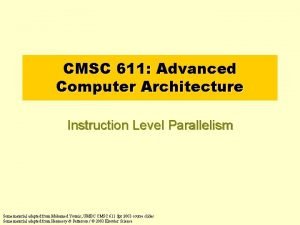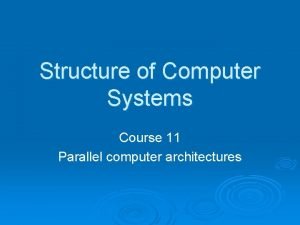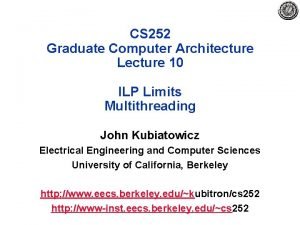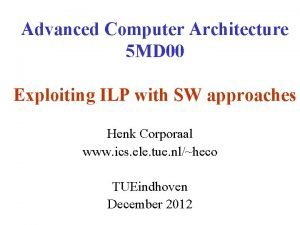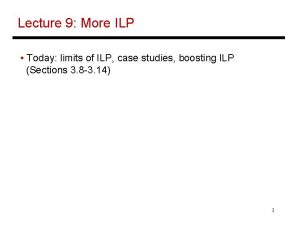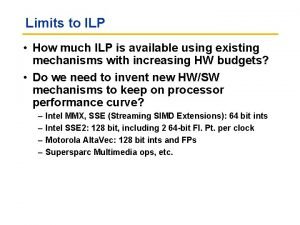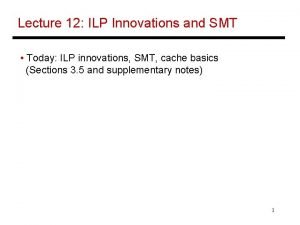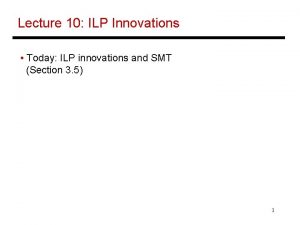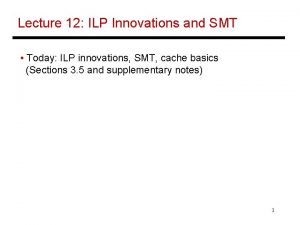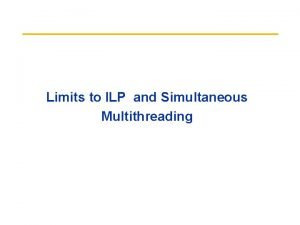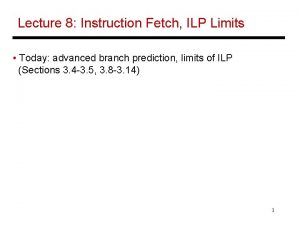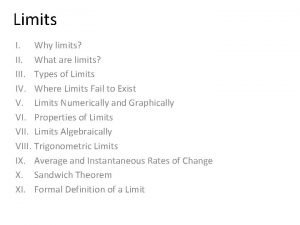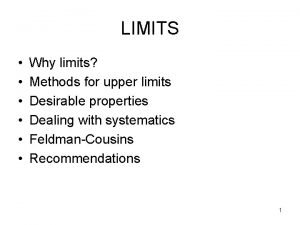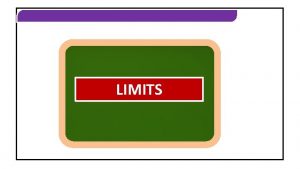Lecture 9 More ILP Today limits of ILP




















- Slides: 20

Lecture 9: More ILP • Today: limits of ILP, case studies, boosting ILP (Sections 3. 8 -3. 14) 1

ILP Limits • The perfect processor: Ø Infinite registers (no WAW or WAR hazards) Ø Perfect branch direction and target prediction Ø Perfect memory disambiguation Ø Perfect instruction and data caches Ø Single-cycle latencies for all ALUs Ø Infinite ROB size (window of in-flight instructions) Ø No limit on number of instructions in each pipeline stage • The last instruction may be scheduled in the first cycle • What is the only constraint in this processor? 2

ILP Limits • The perfect processor: Ø Infinite registers (no WAW or WAR hazards) Ø Perfect branch direction and target prediction Ø Perfect memory disambiguation Ø Perfect instruction and data caches Ø Single-cycle latencies for all ALUs Ø Infinite ROB size (window of in-flight instructions) Ø No limit on number of instructions in each pipeline stage • The last instruction may be scheduled in the first cycle • The only constraint is a true dependence (register or memory RAW hazards) (with value prediction, how would 3 the perfect processor behave? )

Infinite Window Size and Issue Rate 4

Effect of Window Size • Window size is effected by register file/ROB size, branch mispredict rate, fetch bandwidth, etc. • We will use a window size of 2 K instrs and a max issue rate of 64 for subsequent experiments 5

Imperfect Branch Prediction • Note: no branch mispredict penalty; branch mispredict restricts window size • Assume a large tournament predictor for subsequent experiments 6

Effect of Name Dependences • More registers fewer WAR and WAW constraints (usually register file size goes hand in hand with in-flight window size) • 256 int and fp registers for subsequent experiments 7

Memory Dependences 8

Limits of ILP – Summary • Int programs are more limited by branches, memory disambiguation, etc. , while FP programs are limited most by window size • We have not yet examined the effect of branch mispredict penalty and imperfect caching • All of the studied factors have relatively comparable influence on CPI: window/register size, branch prediction, memory disambiguation • Can we do better? Yes: better compilers, value prediction, memory dependence prediction, multi-path execution 9

Pentium III (P 6 Microarchitecture) Case Study • 14 -stage pipeline: 8 for fetch/decode/dispatch, 3+ for o-o-o, 3 for commit branch mispredict penalty of 10 -15 cycles • Out-of-order execution with a 40 -entry ROB (40 temporary or virtual registers) and 20 reservation stations • Each x 86 instruction gets converted into RISC-like micro-ops – on average, one CISC instr 1. 37 micro-ops • Three instructions in each pipeline stage 3 instructions can simultaneously leave the pipeline ideal CPm. I = 0. 33 ideal CPI = 0. 45 10

Branch Prediction • 512 -entry global two-level branch predictor and 512 -entry BTB 20% combined mispredict rate • For every instruction committed, 0. 2 instructions on the mispredicted path are also executed (wasted power!) • Mispredict penalty is 10 -15 cycles 11

CPI Performance • Owing to stalls, the processor can fall behind (no instructions are committed for 55% of all cycles), but then recover with multi-instruction commits (31% of all cycles) average CPI = 1. 15 (Int) and 2. 0 (FP) • Overlap of different stalls CPI is not the sum of individual stalls • IPC is also an attractive metric 12

Alternative Designs • Tomasulo’s algorithm Ø When an instruction is decoded and “dispatched”, it is assigned to a “reservation station” Ø The reservation station has an ALU and space for storing operands – ready operands are copied from the register file into the reservation station Ø If an operand is not ready, the reservation station keeps track of which reservation station will produce it – this is a form of register renaming Ø Instructions are “dispatched” in order (dispatch stalls if a reservation station is not available), instructions begin execution out-of-order 13

Tomasulo’s Algorithm R 1 … … R 1 … Instr Fetch Decode & Issue RS 3 … … RS 3 RS 4 … Register File Stall if no functional unit available Common Data Bus in 1 in 2 ALU Instrs read register operands immediately (avoids WAR), wait for results produced by other ALUs (more names), and then execute, the earlier 14 write to R 1 never happens (avoids WAW)

Improving Performance • What is the best strategy for improving performance? Ø Take a single design and keep pipelining Ø Increase capacity: use a larger branch predictor, larger cache, larger ROB/register file Ø Increase bandwidth: more instructions fetched/ decoded/issued/committed per cycle 15

Deep Pipelining • If instructions are independent, deep pipelining allows an instruction to leave the pipeline sooner • If instructions are dependent, the gap between them (in nanoseconds) widens – there is an optimal pipeline depth • Some structures are hard to pipeline – register files • Pipelining can increase bypassing complexity 16

Capacity/Bandwidth • Even if we design a 6 -wide processor, most units go under-utilized (average IPC of 2. 0!) – hence, increased bandwidth is not going to buy much • Higher capacity (being able to examine 500 speculative instructions) can increase the chances of finding work and boost IPC – what is the big bottleneck? • Higher capacity (and higher bandwidth) increases the complexity of each structure and its access time – for example, access times: 32 KB cache in 1 cycle, 128 KB cache in 2 cycles 17

Future Microprocessors • By increasing branch predictor, window size, number of ALUs, pipeline stages, IPC and clock speed can improve however, this is a case of diminishing returns! • For example, with a window size of 400 and with 10 ALUs, we are likely to find fewer than four instructions to issue every cycle under-utilization, wasted work, low throughput per watt consumed • Hence, a more cost-effective solution: build four simple processors in the same area – each processor executes a different thread high thread throughput, but probably poorer single application performance 18

Thread-Level Parallelism • Motivation: Ø a single thread leaves a processor under-utilized for most of the time Ø by doubling processor area, single thread performance barely improves • Strategies for thread-level parallelism: Ø multiple threads share the same large processor reduces under-utilization, efficient resource allocation Simultaneous Multi-Threading (SMT) Ø each thread executes on its own mini processor simple design, low interference between threads Chip Multi-Processing (CMP) 19

Title • Bullet 20
 Lirik lagu more more more we praise you
Lirik lagu more more more we praise you More more more i want more more more more we praise you
More more more i want more more more more we praise you Limits involving infinity
Limits involving infinity Real limits vs. apparent limits
Real limits vs. apparent limits Limits fits and tolerances lecture notes
Limits fits and tolerances lecture notes 40h11 tolerance
40h11 tolerance 01:640:244 lecture notes - lecture 15: plat, idah, farad
01:640:244 lecture notes - lecture 15: plat, idah, farad Today's lesson or today lesson
Today's lesson or today lesson Today's classes
Today's classes Today's lesson or today lesson
Today's lesson or today lesson Meeting objective
Meeting objective Fingerprint galton details
Fingerprint galton details For todays meeting
For todays meeting 5-1 changing households
5-1 changing households A dollar today is worth more tomorrow
A dollar today is worth more tomorrow A dollar today is worth more than a dollar tomorrow
A dollar today is worth more than a dollar tomorrow Ilp computer architecture
Ilp computer architecture Dlp fo-plp
Dlp fo-plp Tvs industrial & logistics parks pvt ltd
Tvs industrial & logistics parks pvt ltd Ilp
Ilp Ilp computer architecture
Ilp computer architecture
















